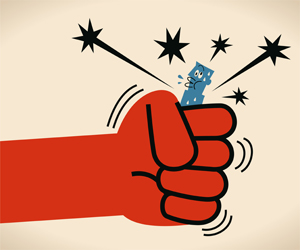Sticking It to Stress
Fran A. Swan, a certified stress management trainer, teaches a 30-second stress relief exercise using stickers as an antecedent to relaxation. According to Swan, today's hectic life-styles cause many people to operate in constant high gear. Our bodies can't cope with this continual state of emergency and the non-abating stress eventually wears down the body's immune systems. "It's like constantly driving your car at 90 mph. If you don't service it, it eventually breaks down," she stated.
Most people don't relate illnesses to stress, but recent research cites stress as a cause or contributing factor in at least 80 percent of all illnesses. "We actually need a certain amount of stress," said Swan. "That's what fuels us. That's our challenge. When we meet a challenge and feel good, that's our recovery period. We get into trouble when we allow the stress to build up without the recovery. It's around these times that we have what I call the breakdown - the stress headache or emotional outburst."
Swan, who is the senior master trainer in stress management for the Veterans Administration, has discovered that many people don't realize that positive occurrences such as promotions, weddings and other celebrations can be stressful, too. She also has found that stressors are different for every person."
All Stress is Individual
 One person's pie is another person's poison," she stated. The sticker exercise that she suggests, therefore, can be tailored to deal with one's own personal stress factors. The sticker exercise includes several simple steps. First, choose a sticker (anything that suits your fancy). Place these stickers around your environment in the places where you most often experience high stress. For example, if being late is a constant stress factor in your life, place a sticker on your watch or clock face. If traffic drives you bonkers, put a sticker on your car's steering wheel or windshield. If your appearance causes you to hyperventilate, slap a sticker on your mirror.
One person's pie is another person's poison," she stated. The sticker exercise that she suggests, therefore, can be tailored to deal with one's own personal stress factors. The sticker exercise includes several simple steps. First, choose a sticker (anything that suits your fancy). Place these stickers around your environment in the places where you most often experience high stress. For example, if being late is a constant stress factor in your life, place a sticker on your watch or clock face. If traffic drives you bonkers, put a sticker on your car's steering wheel or windshield. If your appearance causes you to hyperventilate, slap a sticker on your mirror.
Make sure that your stickers are located where you will see them a minimum of six times a day. Next, whenever you notice a sticker, stop and take three deep abdominal breaths. Inhale for a count of three, then exhale and relax your body muscles.
Deep breathing, a behavior incompatible to stress, forces your body to drop into lower gear. The 30-second pause for deep breathing also makes you more aware of your stressful condition, so that you can recognize when and where it occurs and can learn to deal with it in other environments. Swan suggests limiting yourself to two sticker locations at first. "You can move them around. More than two would dilute the process," she explained.
Later, evaluate your sticker locations by asking yourself two questions: "Do I notice the stickers at least six times a day?" "Do I notice the stickers when I feel most stressed?" If the answer to both of these questions is not "yes", then you should relocate your stickers. As your awareness of and control over those stresses increases, move your stickers to new locations. According to Swan, after three weeks of using this technique, you should notice a marked drop in your stress level. Importantly, Swan suggests a shaping process in dealing with stress. "Work on the little pieces, something you feel makes an immediate difference so that you'll want to continue," she advised. "That positive reinforcement is important, so start simple and work up."


